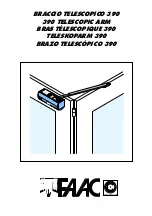
3.8 Connecting the refrigerant pipes
The unit is supplied with plugged direct expansion coil: to ensure its tightness during storage and transport, inside it is loaded nitrogen gas at
a higher pressure than atmospheric.
1)
First loosen the FLARE 1/4 ”union (1) and carry out the leak test, checking that a clear noise is heard due to the outflow of pressurized
nitrogen coming out of the pipe.
2)
Loosen the 1/2 "FLARE pipe union (2) and remove the rubber cap
3)
Prepare the pipes to be connected following the procedure:
Cut the copper tube to the required length with a tube cutter. It is
•
recommended to cut approx. 30 – 50 cm longer than the tubing
length you estimate.
Remove burrs at each end of the cop-
•
per tubing with a tube reamer or file.
This process is important and should be
done carefully to make a good flare. Be
sure to keep any contaminants (moistu-
re, dirt, metal filings, etc.) from entering
the tubing.
Remove the flare nut from the unit and be sure to mount it on the copper tube.
•
Make a flare at the end of the copper tube with a flare tool. A good flare should
•
have the following characteristics:
-
inside surface is glossy and smooth
-
edge is smooth
-
tapered sides are of uniform length
Apply a sealing cap or water-proof tape to prevent dust or water from entering the
•
tubes before they are used.
Be sure to apply refrigerant lubricant (ether oil) to the inside of the flare nut before
•
making piping connections. This is effective for reducing gas leaks.
For proper connection, align the union tube and flare tube straight with each other,
•
then screw on the flare nut lightly at first to obtain a smooth match.
Adjust the shape of the liquid tube using a tube bender at the installation site and
•
connect it to the liquid tubing side valve using a flare.
pag.
1
3
Flare nut
Copper
tubing
Flare tool
Apply refrigerant lubricant.
Union
Flare nut
Indoor unit
Spanner
Torque wrench














































